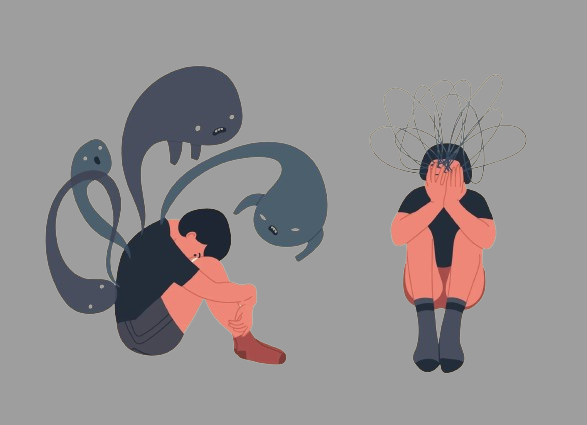Introduction: The Silent Side of Borderline Personality Disorder
Borderline Personality Disorder (BPD) is often portrayed as loud, explosive, and chaotic—an emotional storm that others can see and feel. But not everyone who lives with BPD expresses their struggles outwardly. Some experience an equally painful version that unfolds quietly, hidden beneath a calm surface. This lesser-known form is called Quiet Borderline Personality Disorder, sometimes referred to as high-functioning BPD or internalized BPD.

People with Quiet BPD rarely act out. Instead, they turn their pain inward—battling guilt, shame, self-blame, and a constant fear of being a burden. Their emotional storms rage silently. To the outside world, they may appear composed, even successful, but internally, they wrestle with intense feelings of emptiness, rejection, and self-criticism.
What Is Quiet Borderline Personality Disorder?
Quiet BPD is not an official diagnostic subtype in the DSM-5, but it’s a term clinicians and mental health advocates use to describe a particular internalized pattern of borderline symptoms.
While traditional BPD might involve visible mood swings, impulsivity, and explosive reactions, Quiet BPD manifests through withdrawal, self-directed anger, and emotional suppression. Instead of lashing out, individuals may shut down, isolate, or blame themselves for conflicts and pain.
Common characteristics include:
- Intense fear of rejection or abandonment
- Difficulty expressing anger; turning frustration inward
- Chronic feelings of emptiness or inadequacy
- Perfectionism and people-pleasing tendencies
- Periods of depression or dissociation
- Extreme sensitivity to perceived criticism
The term “quiet” doesn’t mean the symptoms are mild—it simply means they’re hidden. The emotional intensity remains, but it’s often internalized in ways that can lead to self-destructive behaviors or deep emotional exhaustion.
What Does High-Functioning BPD Look Like?
“High-functioning BPD” describes individuals who maintain a successful outward life—careers, relationships, studies—while privately struggling with severe emotional pain. They might be the dependable friend, the perfectionist at work, or the compassionate listener who never asks for help.
Externally, everything seems fine. Internally, however, they may experience:
- Overthinking every interaction, worrying they upset someone.
- Masking emotions to avoid rejection or judgment.
- Inner turmoil—feeling unworthy, unlovable, or fundamentally flawed.
- Emotional burnout from constantly managing others’ perceptions.
A person with high-functioning BPD might spend hours replaying conversations, feeling guilty for speaking up, or apologizing excessively. They often fear conflict so deeply that they suppress their needs entirely, which can lead to resentment, depression, and emotional detachment.
Because they appear “fine,” others rarely see the suffering beneath. Their ability to “hold it together” can become both their shield and prison.
Can Quiet People Have BPD?
Yes—quiet people absolutely can have BPD. Quiet BPD is often mistaken for introversion or social anxiety because of the withdrawn and inward nature of its symptoms. However, introversion and Quiet BPD are not the same.
Introversion is a personality trait—preferring solitude and deep thinking. Quiet BPD, on the other hand, stems from intense emotional dysregulation and fear of rejection.
A quiet person with BPD may not raise their voice, but they might still experience:
- Extreme self-doubt and people-pleasing
- Internal panic over small social missteps
- Fear of abandonment despite appearing calm
- Over-apologizing and self-blame after any disagreement
Cultural and family factors can reinforce this quietness. In environments where emotional expression was punished or discouraged, individuals learn to cope by hiding their feelings. Over time, silence becomes self-protection—but it also deepens the pain of isolation.
Can a Person with BPD Ever Be Normal?
The word “normal” can be misleading, especially when it comes to mental health. While BPD presents real challenges, people with the disorder can absolutely live balanced, fulfilling, and meaningful lives. Recovery doesn’t mean eliminating emotions—it means learning to navigate them with awareness, compassion, and healthier coping tools.
Dialectical Behavior Therapy (DBT), developed by Dr. Marsha Linehan, is one of the most effective treatments. It teaches emotional regulation, mindfulness, and interpersonal effectiveness—skills that help individuals manage their sensitivity without self-destruction.
Other approaches such as Cognitive Behavioral Therapy (CBT), Schema Therapy, and Mindfulness-Based Therapy also play key roles in healing.
Many people with BPD, including those with the quiet subtype, reach a point where they maintain stability, pursue careers, nurture loving relationships, and develop strong self-awareness.
Healing is not about becoming “normal”—it’s about becoming whole.
Is There a Mild Version of Borderline Personality Disorder?
Yes, some individuals experience milder or subclinical forms of BPD, sometimes referred to as having “borderline traits.” They may not meet all diagnostic criteria but still struggle with emotional sensitivity, fear of rejection, and unstable relationships.
Quiet BPD often falls within this subtle spectrum, where the person appears highly functional but experiences inner turmoil.
Even mild versions deserve recognition and care. Left unaddressed, emotional suppression can lead to depression, burnout, or self-sabotaging behaviors. Early self-awareness and therapy can prevent escalation and promote emotional resilience.
Emotional Experience of Quiet BPD: Inside the Mind
Living with Quiet BPD feels like being in a constant emotional tug-of-war—between wanting closeness and fearing rejection, between self-blame and yearning for validation.
Inside, the dialogue may sound like:
“I don’t want to upset anyone.”
“They’ll leave if they see the real me.”
“I shouldn’t feel this way—it’s my fault.”
This silent battle drains energy and self-worth. People with Quiet BPD often feel invisible, misunderstood, or “too much” even when they’re doing everything to seem easygoing.
Over time, the suppression of emotions can lead to emotional numbness, self-isolation, and deep sadness. Yet beneath the silence lies incredible empathy and sensitivity—a heart that feels everything, perhaps too much.
Causes and Risk Factors of Quiet BPD
Like all forms of BPD, Quiet BPD results from a complex interplay of biological, environmental, and psychological factors.
1. Childhood trauma or neglect: Emotional invalidation, abandonment, or abuse can shape deep-seated fears of rejection.
2. Genetic predisposition: Research shows BPD can run in families due to heritable emotional sensitivity.
3. Neurobiological differences: Imbalances in serotonin or heightened amygdala activity may contribute to intense emotional reactivity.
4. Environmental influences: Growing up in a household that discouraged emotional expression often teaches suppression as survival.
Quiet BPD can be seen as the result of trauma turned inward—where the person learned that silence and self-blame were safer than conflict or rejection.
Diagnosis and Misunderstanding
Quiet BPD is frequently misdiagnosed as depression, anxiety, or complex PTSD because its symptoms overlap significantly. Patients often report low mood, guilt, and withdrawal, which can mask the underlying borderline traits.
Clinicians unfamiliar with internalized BPD may overlook signs such as hypersensitivity to rejection or chronic self-criticism.
A proper diagnosis requires a comprehensive evaluation by a licensed mental health professional—someone who understands how BPD manifests differently in each individual.
Accurate diagnosis isn’t about labeling—it’s about unlocking the right treatment path and validating the person’s lived experience.
Treatment and Healing Pathways
Healing from Quiet BPD begins with self-understanding and safe emotional expression. Recovery is entirely possible with commitment, patience, and support.
1. Therapy
- Dialectical Behavior Therapy (DBT): Builds mindfulness, emotional regulation, distress tolerance, and interpersonal skills.
- Cognitive Behavioral Therapy (CBT): Helps identify and reframe harmful thought patterns.
- Schema Therapy: Addresses deep-rooted beliefs of unworthiness or abandonment.
- EMDR (Eye Movement Desensitization and Reprocessing): Useful for trauma-linked symptoms.
2. Self-Help and Lifestyle Tools
- Journaling to identify triggers and express emotions safely.
- Mindfulness and grounding exercises to stay present.
- Healthy boundaries to avoid emotional burnout.
- Creative outlets like writing, art, or music as emotional release.
3. Support Systems
Having a trusted therapist, peer group, or supportive friend makes a profound difference. Quiet BPD thrives in isolation—connection is the antidote.
Progress is rarely linear, but even small victories—setting a boundary, expressing a feeling, forgiving oneself—signal growth.
Supporting Someone with Quiet BPD
If someone you love has Quiet BPD, the best gift you can offer is understanding without judgment.
Do:
- Listen with empathy instead of offering quick solutions.
- Reassure them that emotions don’t make them “too much.”
- Encourage therapy and emotional honesty.
- Set healthy boundaries while showing compassion.
Don’t:
- Dismiss their pain or tell them to “just move on.”
- Take withdrawal personally—it’s often fear, not rejection.
- Assume they’re fine just because they seem calm.
Loving someone with Quiet BPD requires patience and emotional awareness, but the relationship can also be profoundly rewarding. People with Quiet BPD are often deeply caring, loyal, and capable of immense emotional insight once they feel safe.
Conclusion: Breaking the Silence Around Quiet BPD
Quiet Borderline Personality Disorder hides behind smiles, politeness, and composure. Beneath that calm exterior, however, lies deep emotional pain and a longing for understanding.
By recognizing the quieter side of BPD, society can move beyond stereotypes—seeing not just the “drama,” but the human being who has learned to suffer in silence.
Quiet BPD is not a life sentence. With compassion, therapy, and awareness, individuals can unlearn self-blame, build healthy relationships, and rediscover peace within themselves.
Healing begins the moment we stop hiding and start being seen.



